Banksy's legacy amid steelworks loss fuels new play
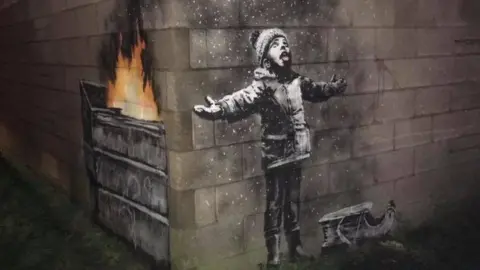 Scott Bamsey
Scott BamseyWhat happens to a town when the UK's most talked about artist leaves an unannounced drawing on a garage wall?
Season's Greetings, by the anonymous artist Banksy, appeared in Port Talbot in December 2018, days before Christmas, prompting a rush of visitors to swell the back lanes where the commentary on the town's famous steel industry now resided.
The drawing, across two walls at right angles, showed a boy playing joyously in a downfall of snow – but turn the corner and the viewer sees the "snow" is actually ash falling from a fire burning in a bin, echoing the larger plumes of smoke emitted day and night at the steelworks.
Now that event – and the wider story of the town's fate – has been turned into a play, Port Talbot Gotta Banksy, based entirely on transcripts of the townsfolk's response.
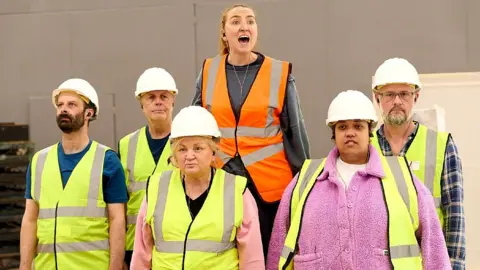 Mark Douet
Mark DouetTracy Harris and Paul Jenkins, south Wales-based playwrights, had worked together on a previous project using the same technique of verbatim speech, that time gathered from young people they were devising a show with, and were looking for ideas for another.
When they heard about the Banksy and went to visit, a chance conversation with a fellow director who said "someone should write a play about this" gave Paul "one of those lightbulb moments," that the material might be right under their noses.
However neither anticipated that what began as a plan to capture the response to a singular event would grow into a six-year labour of love documenting the end of a 100-year way of life for a working-class community.
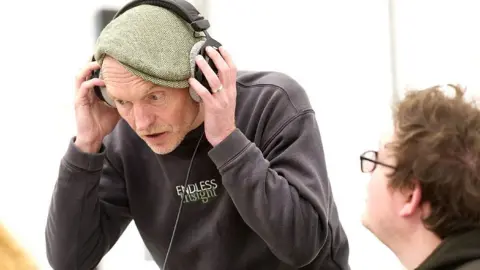 Mark Douet
Mark DouetPaul said of Season's Greetings: "It was a beautiful piece of art and we realised that the people in Port Talbot recognised that as well and they really, really loved it and took it into their hearts."
"We were at the site every day, talking and listening to the community's opinions and feelings and responses to the Banksy, what they thought about the theme of it, the pollution, steelworks, all of that. And it just started there."
A version of the play could have happened at an earlier point but then "Covid happened".
 Tracy Harris
Tracy Harris"And then by a stroke of luck or genius, the story kept developing," said Tracy.
There were the twists and turns with the artwork itself – first it was protected by security at the site, then bought by an English art collector to go on display in the town, with a promise it would always remain there.
That failed to happen and the piece was finally removed to an undisclosed location in England in February 2022.
But the other story which weaved into and over the Banksy was the devastating news that steel production as it had existed for most people's lifetimes would end.
And it was only when the works' blast furnace got switched off in September 2024 that Tracy and Paul finally decided it was time to stop gathering interviews and devise the play.
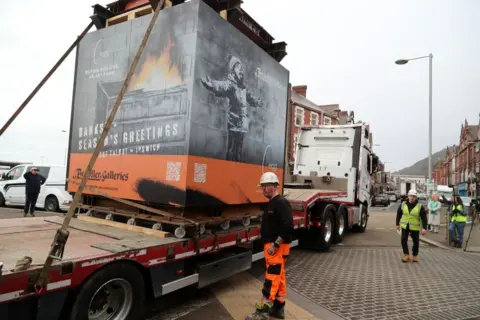 Getty Images
Getty ImagesOver the course of six years the pair collected more than 100 hours of recordings that they have managed to boil down to a two-hour play.
"It's made it such a universal story now, much bigger than what we originally thought," said Tracy.
Paul added: "When we started, we thought it was going to be a story about the Banksy, the first Banksy in Wales and what people thought of it.
"But of course it became much more about the theme of the Banksy, drawing attention to the pollution from the steelworks, and then of course when the threat to the steelworks [happened] it's become much more a gritty portrait of that community and their resilience.
"They were gifted the Banksy at Christmas – that was taken away from them. And now the blast furnaces, the industry that they've had for 100 years, although hopefully it is going to transition to green steel and an electric arc furnace, at the moment the blast furnaces have just been switched off.
"So there's this terrible sense of uncertainty hanging over the town. The pollution, the theme that Banksy highlighted, is gone, but at the cost of thousands and thousands of jobs in the town."
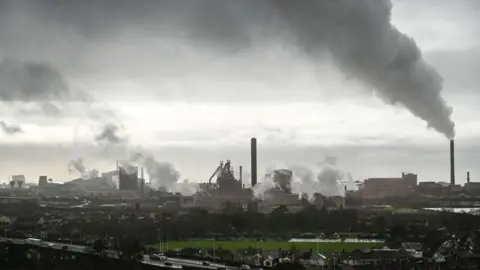 Getty Images
Getty ImagesEvery word said on stage is an absolute reproduction of words spoken by real people. Six actors represent people Tracy and Paul went back to again and again over the years as well as a host of other voices.
Even their lines are not learned but delivered through headsets directly to the actors as they say them.
The tale is told in chronological order but from a wide range of differing perspectives, with some news reports and headlines added to help the audience understand the latest development where necessary.
One of the people represented in the show is a steelworker who's started spray painting, highlighting a type of transformation that has occurred within the town even as it faces the consequences of the loss of its industrial heritage.
Tracy said: "Port Talbot's become the street art capital of Wales suddenly. Even though it's a sad story, it's also a story of hope because [the people] do bounce back.
"They've decided to make the town a colourful town and start spray painting everywhere."
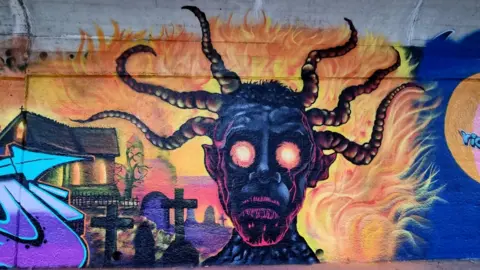 Ryan Davies
Ryan Davies"The legacy of the Banksy is there's an incredible street art scene now. So many local artists, so many walls are covered in colour and amazing art," adds Paul.
"The colour of the town has changed. It's gone from being a grey, industrial town where the skies are full of smoke all the time to being a really colourful town."
Doing the research for the play helped give voice to people who "often have no say in what's happening", but it also revealed to the pair the breadth of talent across the arts in Port Talbot.
"What's beautiful about this play is you see it from a community's point of view, and you see it from all those voices you would never normally hear, who would never get a chance to tell their side of the story and what that art meant to them and how important it was to their town," says Tracy.
"It's so poetic sometimes the way they describe it."
Paul says at the start of the process they had assumed at some points they would have to write in some lines to join the pieces of the story together, but found that their interviewees had done it for them naturally.
"The people of Port Talbot are incredible storytellers. I don't know what it is – it's probably a Welsh thing, it's definitely a Port Talbot thing – they are very good at telling their story," he says.
Tracy chips in: "We couldn't have asked for them to say anything better. It's almost like you couldn't write it sometimes. You're like, 'how did you say that? It's exactly what we needed you to say'."
Port Talbot Gotta Banksy is at the Sherman Theatre, Cardiff, from 2-10 May and then on tour to Port Talbot, Swansea, Milford Haven and Wrexham.
